Ethereum price is a turnaround play — and that’s not necessarily a bad thing.
While the price of Solana hogs headlines with momentum and “impressive” exchange-traded fund launches, Ethereum is dealing with a different narrative: recovery from depression. But according to Matt Hougan, Bitwise’s chief investment officer, that creates opportunity.
“Ethereum is very much staring down $5,000 by the end of the year and doubling or more by the end of the decade,” Hougan told DL News.
To get there requires understanding what went wrong — and what’s changing.
The depression
For some time, Ethereum’s community had been down and out.
The blockchain that pioneered smart contracts and laid the groundwork for decentralised finance has faced existential questions about its relevance.
Earlier this year, many of Ethereum’s most loyal believers were worried that the vibes were off, in no small part because of months of bad news.
Activity on Ethereum languished, without a clear trigger to kickstart growth. Detractors said that the idea to scale through separate layer-2 networks had backfired, which took a toll on the network’s token economics and drained value from the main chain.
Others even said that the network was overvalued and uninvestable.
The stablecoin thesis
But Hougan sees a structural advantage that Ethereum bears are missing: stablecoins.
“All payments will be on stablecoins,” he said. And where do most stablecoins live? Ethereum.
USDT ($1.01) and USDC ($1.00) — which account for more than two-thirds of the stablecoin sector — are predominantly issued on Ethereum’s blockchain.
Over 53% of the $307 billion stablecoins in circulation runs on Ethereum, according to data from DefiLlama. Solana, by comparison, makes up for just over 4% of the total supply.
As traditional finance embraces stablecoins for payments, settlement, and treasury management, Ethereum becomes the infrastructure layer.
Many activities ranging from JPMorgan accepting crypto as collateral, and Ripple spending $1 billion bringing stablecoins to corporate treasuries to BlackRock’s tokenised treasury fund growing to $2.5 billion — all generate fees for Ethereum.
The more stablecoins move, the more Ethereum earns. And stablecoin volumes are accelerating, not slowing.
Other Wall Street bigwigs also see stablecoins as the killer use-case for Ethereum.
“Stablecoins are “the ‘ChatGPT’ of crypto because of its viral adoption,” Tom Lee, Wall Street strategist and chairman of the largest Ethereum treasury company, told CNBC on June 30.
“Underneath the stablecoin industry is Ethereum — the backbone and architecture.”
Lee is putting his money where his mouth is as well. His company, Bitmine, now holds $12 billion in Ether.
Institutional infrastructure
Ethereum’s other advantage: it’s still the default for institutions building blockchain infrastructure.
The second most valued crypto network commands deeper liquidity, more developer talent, and established regulatory frameworks. It’s the conservative choice for enterprises entering crypto.
That matters for long-term holders — Ethereum has staying power. When traditional finance tokenises trillions of dollars in assets over the next decade, most of that will happen on Ethereum first.
Hougan frames it as a classic turnaround: depressed sentiment, structural advantages intact, and a clear catalyst — stablecoin adoption — that’s already underway.
The treasury trade
Beyond building on Ethereum, institutions are also keen for the cryptocurrency itself.
In the past months, Ethereum treasuries — companies that hold Ether on their balance sheets — have exploded onto the market.
According to strategicethreserve.xyz, 70 companies hold more than 6 million Ether worth about $23 billion. Ethereum treasuries have surpassed Bitcoin companies in terms of total supply held, now sitting at around 4.7% versus Bitcoin’s 3.5%.
But even if their stock prices don’t rise in tandem with their purchases, that doesn’t mean Ethereum’s price doesn’t rally.
Getting $10,000 from $4,000 requires Ethereum to deliver on its staking, scaling, stablecoin narratives, and sustained institutional demand.
But if those pieces fall into place, doubling from current levels by 2030 is “very much” achievable, according to Hougan.
Pedro Solimano is DL News’ Buenos Aires-based markets correspondent. Got a tip? Email him at psolimano@dlnews.com.
.png)


























 24h Most Popular
24h Most Popular








 Utilities
Utilities